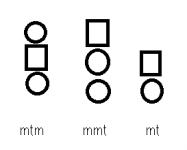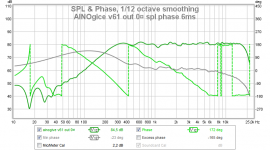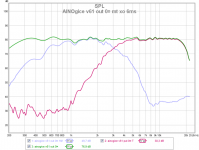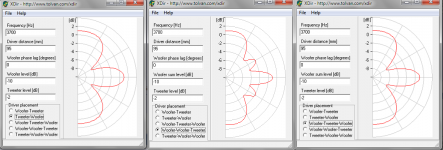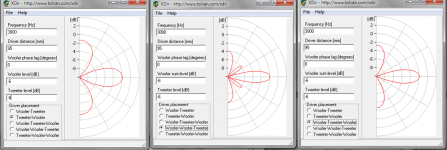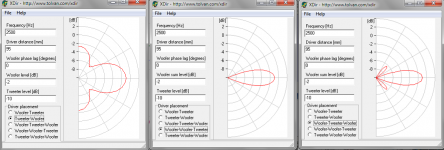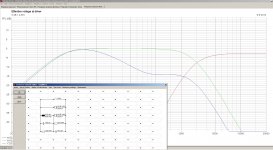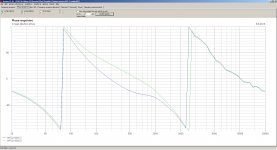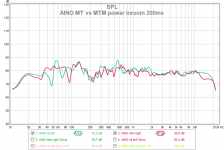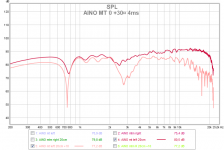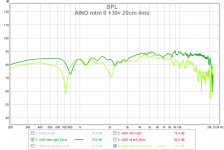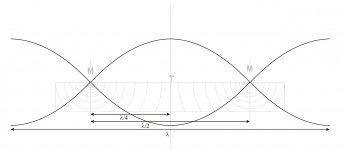I'm considering having two mids in my active 3-way, because i like all the highly positive comments on the small scanspeak 10F, but would like a bit more power handling. They'll be sealed (or just possibly ported), not dipole. Probably I'd have the drivers one vertically above the other to avoid horizontal lobing, and as close together as possible to at least minimise vertical lobing.
Even the small 10F would be around 100mm between centers so if I understand correctly they'll exibit vertical lobing at around 200mm wavelengths, or 1.7kHz, and above. Which would almost certainly be below my crossover frequency (not chosen yet but is likely to be at least 2.5kHz/3kHz or more).
In practice am I likely to notice any lobing or other detrimental effects between seated and standing heights at say 3m from the speakers?
Thanks,
Kev
Even the small 10F would be around 100mm between centers so if I understand correctly they'll exibit vertical lobing at around 200mm wavelengths, or 1.7kHz, and above. Which would almost certainly be below my crossover frequency (not chosen yet but is likely to be at least 2.5kHz/3kHz or more).
In practice am I likely to notice any lobing or other detrimental effects between seated and standing heights at say 3m from the speakers?
Thanks,
Kev
We cross them @ ¼ wavelength and space the same. This would be around 3.4kHz in your case. Measurements before making such a design change must reflect this to ensure symmetry. Keys to making an MTM work proper are distance between drivers to acoustic center of the tweeter at the same point it is crossed, combined with baffle width of ½ wavelength eg ¼ wave to either side of drivers acoustic center at the same frequency.I'm considering having two mids in my active 3-way, because i like all the highly positive comments on the small scanspeak 10F, but would like a bit more power handling. They'll be sealed (or just possibly ported), not dipole. Probably I'd have the drivers one vertically above the other to avoid horizontal lobing, and as close together as possible to at least minimise vertical lobing.
Even the small 10F would be around 100mm between centers so if I understand correctly they'll exibit vertical lobing at around 200mm wavelengths, or 1.7kHz, and above. Which would almost certainly be below my crossover frequency (not chosen yet but is likely to be at least 2.5kHz/3kHz or more).
In practice am I likely to notice any lobing or other detrimental effects between seated and standing heights at say 3m from the speakers?
Thanks,
Kev
I am now thinking about this same problemacy!
I use just a 3" upper mid (nude no baffle) and chose mtm arrangement. I can listen to it in mt too (changing wiring), but it is hard to hear a difference. I can easily measure a difference and with sine tones I can hear vertical lobing of mtm. Changing to mmt would mean making a new frame for drivers.
My mids ¤ is 95mm and height of tweeter is 95mm (cut-outs have been made in the frame), width 98mm
I use just a 3" upper mid (nude no baffle) and chose mtm arrangement. I can listen to it in mt too (changing wiring), but it is hard to hear a difference. I can easily measure a difference and with sine tones I can hear vertical lobing of mtm. Changing to mmt would mean making a new frame for drivers.
My mids ¤ is 95mm and height of tweeter is 95mm (cut-outs have been made in the frame), width 98mm
Attachments
Last edited:
Xdir from Tolvan data is a simple simulation. I just have difficulties understanding what parameters are valid and what phase setting to use. I have actuallly played with it a lot but I don't know which simulation is valid when I toggle between mt, mtm, mmt etc. There is only one setting for d (istance between drivers) - m to t I guess but what is correct for a mtm or mmt?
I have picked m and t levels from individual measured acoustic responses around xo. Phase match is good, do I keep woofer phase lag at 0 then?

I have picked m and t levels from individual measured acoustic responses around xo. Phase match is good, do I keep woofer phase lag at 0 then?

Juha when I was commenting before I presumed we were discussing a 4" driver. My bad. 😱
A cross point of ~4.3kHz and ¼ wavelength of this frequency above/below the tweeters acoustic center would be appropriate for you.
A cross point of ~4.3kHz and ¼ wavelength of this frequency above/below the tweeters acoustic center would be appropriate for you.
Thanks greebster (yet again!). I hadn't actually got as far as the tweeter, just the two F10 mids, but yes that would have been my next question. For some reason I seem to prefer the idea of having the mids together (and so acting as similarly as possible to a single mid) with the tweeter on top, but I understand why some systems have the more symmetrical setup of the tweeter between two mids and its certainly got something going for it
Cheers
kev
Cheers
kev
My MT vs MMT vs MTM parameters
Mids Peerless/Vifa NE95 flange diameter 95mm
Twwet Fountek NeoCD3.5H flange height cut to 95mm, width 98mm
Measured m to t xo responses and phase of the system (when playing mtm), outdoors at 150cm distance mic at tweeter level.
Next post Xdir simulations...
p.s. Sorry Kev06, actually I have been preparing to open a thread of this topic myself. I hope that we can combine our efforts in R&D!
Mids Peerless/Vifa NE95 flange diameter 95mm
Twwet Fountek NeoCD3.5H flange height cut to 95mm, width 98mm
Measured m to t xo responses and phase of the system (when playing mtm), outdoors at 150cm distance mic at tweeter level.
Next post Xdir simulations...
p.s. Sorry Kev06, actually I have been preparing to open a thread of this topic myself. I hope that we can combine our efforts in R&D!
Attachments
You could use 1 of the mids as a ".5" driver (BSC). That should help with lobing / comb filter effects. I am looking into this to improve my MTM (http://www.diyaudio.com/forums/multi-way/207159-trinium-my-latest-build.html), which has a hugh MTM spacing because of the NeoCD2.0 tweeter used.
After alot of sims in Boxsim I think I like a notch + lowpass (effectively forming a shelving filter with a second order rolloff) best for this application, at least in my case. I attached a snapshot of the directivity of this config, in the Trinium thread there is a sim of the "old" config. Should give you an idea of the effect.
After alot of sims in Boxsim I think I like a notch + lowpass (effectively forming a shelving filter with a second order rolloff) best for this application, at least in my case. I attached a snapshot of the directivity of this config, in the Trinium thread there is a sim of the "old" config. Should give you an idea of the effect.
Attachments
Last edited:
Mark, sorry I am using all channels in my minidsp - but perhaps i can do a passive filter for the other M?
But here are Xdir simulations of the system above. I use phase difference=0
Xo is unchanged but we look at simulation at xo point 3000Hz (both -6dB (LR4) and at 2500Hz when T = -10dB and at 3700Hz when M = -10dB
Analysis, please!
But here are Xdir simulations of the system above. I use phase difference=0
Xo is unchanged but we look at simulation at xo point 3000Hz (both -6dB (LR4) and at 2500Hz when T = -10dB and at 3700Hz when M = -10dB
Analysis, please!
Attachments
Hi Juhazi,
That looks like a narrow dispersion pattern, don't know if that's your goal? You can try simming your design in Boxsim like I did (Downloads). Should give you a better idea of the response. I also have "only" 2 channels of DSP / speaker available so I am designing a passive filter for the .5 config. Not that hard to do if you use Boxsim. I attached a sim of the filter to show the idea.
That looks like a narrow dispersion pattern, don't know if that's your goal? You can try simming your design in Boxsim like I did (Downloads). Should give you a better idea of the response. I also have "only" 2 channels of DSP / speaker available so I am designing a passive filter for the .5 config. Not that hard to do if you use Boxsim. I attached a sim of the filter to show the idea.
Attachments
Last edited:
About NE95 mids (fullranges acually) Tymphany calls these 3"
driver flange diameter 95mm (almost 4")
driver membrane diameter 60mm 2,5")
Mms 2,5g
So shall we call this 4" or 3"?
Here is the datasheet of the SS10F4424 used by John K in NaO Note and Kev06's plans. Price for 2x NE95 equal one SS10F, both have neodymium magnets but NE has an even smaller diameter magnet which is good for dipole.
Mark, I use NE95 as dipoles in my almost finished project http://www.diyaudio.com/forums/multi-way/231353-aino-gradient-collaborative-speaker-project.html The dipole correction needed at the low end makes me specially concerned of Xmax and distortion at high levels!
driver flange diameter 95mm (almost 4")
driver membrane diameter 60mm 2,5")
Mms 2,5g
So shall we call this 4" or 3"?
Here is the datasheet of the SS10F4424 used by John K in NaO Note and Kev06's plans. Price for 2x NE95 equal one SS10F, both have neodymium magnets but NE has an even smaller diameter magnet which is good for dipole.
Mark, I use NE95 as dipoles in my almost finished project http://www.diyaudio.com/forums/multi-way/231353-aino-gradient-collaborative-speaker-project.html The dipole correction needed at the low end makes me specially concerned of Xmax and distortion at high levels!
Last edited:
About NE95 mids (fullranges acually) Tymphany calls these 3"
driver flange diameter 95mm (almost 4")
driver membrane diameter 60mm 2,5")
Mms 2,5g
So shall we call this 4" or 3"?
Here is the datasheet of the SS10F4424 used by John K in NaO Note and Kev06's plans. Price for 2x NE95 equal one SS10F, both have neodymium magnets but NE has an even smaller diameter magnet which is good for dipole.
Mark, I use NE95 as dipoles in my almost finished project http://www.diyaudio.com/forums/multi-way/231353-aino-gradient-collaborative-speaker-project.html The dipole correction needed at the low end makes me specially concerned of Xmax and distortion at high levels!
That's a big thread, will need some time to digest it all... On a side note: Been on a business trip to Finland a couple of years ago, visited Helsinki, Tampere and Vaasa, what a nice country! Friendly people (all seem to speak English), almost no traffic jams and excellent vodka!
I have done also inroom measurements (quick and dirty) of MT vs MTM using the left speaker as MT and right as MTM. Position is similar as it can be in a living room but mic position is not exactly equal - so pay attention to major outlines only!
Farfield (power response) 200cm 200ms and nearfield 20cm 4ms (30¤ angle upwards but poor summation because of small distance).
Farfield (power response) 200cm 200ms and nearfield 20cm 4ms (30¤ angle upwards but poor summation because of small distance).
Attachments
Last edited:
Please feel free - you're currently further along than I am with this, so I may not contribute much for a while, but its all useful.p.s. Sorry Kev06, actually I have been preparing to open a thread of this topic myself. I hope that we can combine our efforts in R&D!
Cheers
kev
I have done also inroom measurements (quick and dirty) of MT vs MTM using the left speaker as MT and right as MTM. Position is similar as it can be in a living room but mic position is not exactly equal - so pay attention to major outlines only!
Farfield (power response) 200cm 200ms and nearfield 20cm 4ms (30¤ angle upwards but poor summation because of small distance).
In this measuremnt the MTM looks slightly better, what's the angle of the off axis measurement?
Edit: just noticed 30 degrees, duh...
Those dips are pretty deep -10dB on axis, could be the room interfering with measurement? If so, not much can be learned from these measurements.
Last edited:
This subject is really troblesome...
I analyze data and simulations above like this:
- There is not a significant difference in simulations at this configuration and xo 3000Hz
- power response in the range of Ms of a MTM is hotter than MT's (on axis is same, not shown here)
- my nearfield measurement are reliable but not valid - too close --> do outdoors at 100cm distance
A measurement doesn't always measure the phenomenon in question (poor validity). How to get valid data about this (the ill lobing)? Listening tests are problematic too, unless there is a really big difference. I can't hear a difference between these in a room. In my project I was aiming at high directivity both horizontally and vertically to minimize early reflections. On-axis and power response relation shows that this is achieved, also imaging in stero is better than average 2-way speakers with waveguides. However the question about problematic lobing is not answered.
I will do better outdoor measurements some day with a friend - perhaps next weekend. I must make some kind of guide/ruler for angles.
I analyze data and simulations above like this:
- There is not a significant difference in simulations at this configuration and xo 3000Hz
- power response in the range of Ms of a MTM is hotter than MT's (on axis is same, not shown here)
- my nearfield measurement are reliable but not valid - too close --> do outdoors at 100cm distance
A measurement doesn't always measure the phenomenon in question (poor validity). How to get valid data about this (the ill lobing)? Listening tests are problematic too, unless there is a really big difference. I can't hear a difference between these in a room. In my project I was aiming at high directivity both horizontally and vertically to minimize early reflections. On-axis and power response relation shows that this is achieved, also imaging in stero is better than average 2-way speakers with waveguides. However the question about problematic lobing is not answered.
I will do better outdoor measurements some day with a friend - perhaps next weekend. I must make some kind of guide/ruler for angles.
For using double mids, look at some of David Smith's work on his "Expanding Array" MTM units for Snell. (Mr. Smith posts here as "speaker dave.") I think he wrote an AES paper on these arrays, too. (IIRC, he used Vifa M10 mids and an Audax neo tweeter in a waveguide, but the Scan Disco 10F and any suitably small-motor tweeter loaded into a waveguide that can handle the necessary crossover point would work.
That's the way, IMO, to use double mids.
That's the way, IMO, to use double mids.
Now if the drivers are too far apart visualize the same wavelength but two of them separated by a gap created by this excess distance. This physical gap induces phase shift causing your issue in the vertical axis.
In my mtm system m-t center to center distance is 95mm and m to m 190mm
L/2 is 3600Hz and L/4 is 1800Hz. My tweeeter can't go with 1,8kHz xo. I will simulate and measure it after setting xo to 3600Hz (now it's 3000) There is no way to make m-t shorter any more, so mt should be better but they have always some lobing too.
Vertical lobing is not so bad as horizontal. If I can't eliminate lobing, I want to minimize it. By simulations mmt is not a the way to go with my dimensions and xo.xo
.5 config creates phase difference below xo and I don't want that at these frequencies. I must study the hint that Pallas gives.
L/2 is 3600Hz and L/4 is 1800Hz. My tweeeter can't go with 1,8kHz xo. I will simulate and measure it after setting xo to 3600Hz (now it's 3000) There is no way to make m-t shorter any more, so mt should be better but they have always some lobing too.
Vertical lobing is not so bad as horizontal. If I can't eliminate lobing, I want to minimize it. By simulations mmt is not a the way to go with my dimensions and xo.xo
.5 config creates phase difference below xo and I don't want that at these frequencies. I must study the hint that Pallas gives.
- Status
- Not open for further replies.
- Home
- Loudspeakers
- Multi-Way
- Twin mids and lobing
